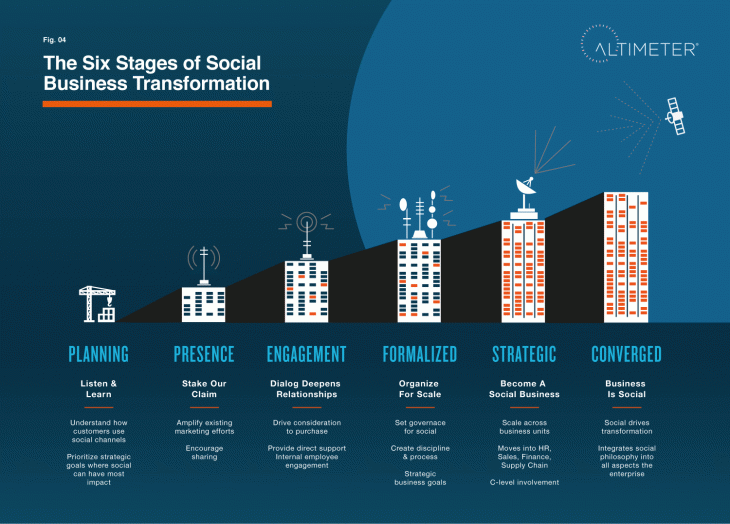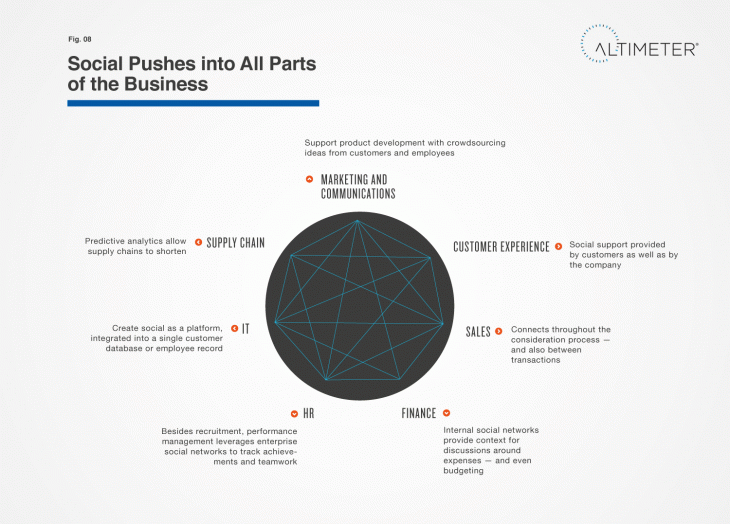
Being social is not something every company can do well. In fact, according to a new report from the research firm Altimeter Group, there are companies that fit along one of six stages of “social business maturity”. The idea is that eventually companies will achieve a social “nirvana” and finally understand how their social media strategies can be tied directly to business goals while also making sure that the whole company is tied into that social process.
Produced by Charlene Li and Brian Solis, The Evolution of Social Business: Six Stages of Social Business Transformation surveyed approximately 700 social media professionals and executives. From that, it discovered 34 percent of businesses said they felt their social strategy was connected to business outcomes. The authors make it clear that there are two different kinds of social strategies: a social media and a social business one.
With a social media strategy, a company lays out the channels, platforms, and tactics that are used to support publishing, listening and engagement. On the other hand, in using a social business strategy, relevant technologies and processes are integrated into business values and practices in order to build relationships and cause conversations to happen both in the organization and outside. Both Li and Solis say it will create value and optimizing impact for customers and the business.
The six stages of social business maturity
In their report, Li and Solis say that there is a natural progression for companies as social is tied into how the business is run. In all, there are six distinct stages: Planning, Presence, Engagement, Formalized, Strategic, and Converged.
With Planning, companies set out to create a strong foundation for strategy development, organizational alignment, resource development, and execution. The report says that those in this stage will be listening to their customers to understand their social behavior and will use pilot projects in order to prioritize social efforts. An audit may be used to assess an organization’s readiness for customer demands.
In the second stage, Presence, companies begin to shift from planning to action with the creation of a formal and informed social media presence. Altimeter says that tenets in this stage include using existing social content to further any marketing efforts, providing information to support post-transaction issues, and making sure all departmental or business objectives have the same metrics being counted.
Eventually, companies move towards the third stage, Engagement, where social media becomes less of a novelty and instead is a mandatory part of its existence, specifically in relationship building. Those at this point will have people building communities, engaging and influencing customers, participating in any dialogue relating to their company and customers, and also formulating a risk management and training discipline to handle any crisis. It will also see the beginnings of the age of employee engagement.
A Formalized approach is the next evolution whereby Li and Solis say three key activities will be the focus. First of all, establish an executive sponsor — an executive inside the company who proactively seeks to empower an internal strategist or an outside agency who advocates for social business. Secondly, the creation of a social business hub is recommended. Lastly, companies need to establish organization-wide governance policies.
The fifth stage is Strategic. Organizations start to become more mature and is capturing more attention from C-level executives and department heads who see the benefit of being social. Social operations is beginning to span out into various business units.
In the final stage, Convege, the business has become social and it’s here where companies commit to a single business strategy process — social merges with digital, holistic customer experience are created using converged media, and a social culture is formed.
What does this all mean?
In reading this report, it’s clear that the Altimeter Group and those that were surveyed by the firm aren’t against the use of social media. Rather, it’s more of a lack of understanding of how it can be used to help accomplish the business objectives of any company. These six steps are all part of the evolutionary process where in the beginning a community manager might be the lone representative and as customers become more socially aware, so too must the company and that’s when it will need to further develop its understanding.
Both Li and Solis point out that this social progression will not happen overnight and may even take years before it achieves this social “nirvana”. Along that journey, the authors admit that companies are bound to encounter some challenges, specifically that in most organizations, social media is still viewed as operating largely in a vacuum — remember that common question: “Who’s responsible for social media?” Based on this report, out of those surveyed, 40 percent believed marketing, while 26 percent said corporate communications or PR. The remaining percentage was divided up among social media, digital, and other departments.
Photo credit: Spencer Platt/Getty Images
Get the TNW newsletter
Get the most important tech news in your inbox each week.






